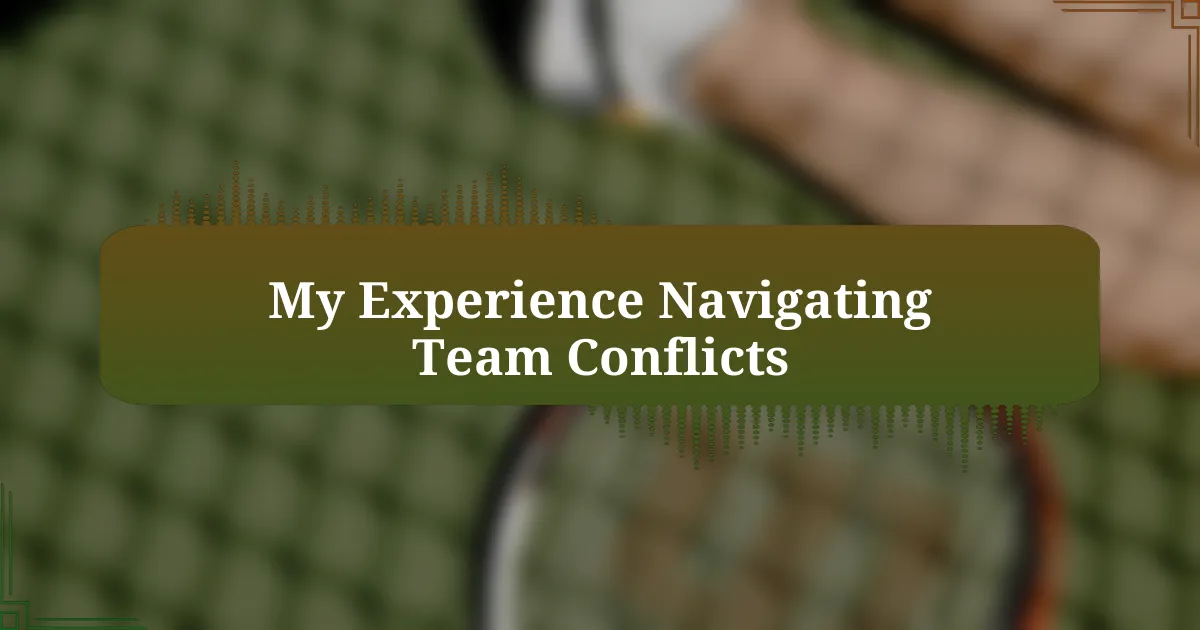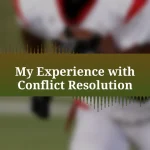Key takeaways:
- Conflicts in teams often arise from miscommunication and differing playing styles, highlighting the importance of clear communication and understanding expectations.
- Effective resolution strategies include open discussions, encouraging compromise, and fostering a supportive culture to mitigate conflicts.
- Personal experiences reveal that addressing team tensions early can prevent escalation and that empathy can transform negative situations into growth opportunities.
- Building a cohesive team environment requires connection, vulnerability, and regular team-building activities to enhance collaboration and performance.
Author: Evelyn Harper
Bio: Evelyn Harper is an award-winning author known for her evocative storytelling and rich character development. With a background in psychology, she weaves intricate narratives that explore the complexities of human relationships. Her debut novel, “Whispers in the Wind,” received critical acclaim and established her as a fresh voice in contemporary fiction. A graduate of the Iowa Writers’ Workshop, Evelyn resides in Portland, Oregon, where she continues to write and inspire aspiring authors through workshops and mentorship. When not immersed in her writing, she enjoys hiking the Pacific Northwest trails and sipping coffee at local cafes.
Understanding team conflicts
Conflicts within a team often stem from diverse personalities and playing styles. I remember one specific match where I clashed with a teammate over strategy, and it felt as if the atmosphere had thickened with tension. Was I too stubborn, or did I genuinely believe my approach was better? That moment forced me to reflect deeply on the importance of communication in overcoming such disagreements.
Understanding the root of team conflicts is essential to resolve them effectively. I once witnessed a situation where two players had completely different views on how to approach a crucial game, leading to frustration on both sides. It made me realize that sometimes, it was not just about the game plan but also about unmet expectations and misunderstandings that escalated the issue.
What surprised me most was how quickly resentment could build if conflicts are left unaddressed. There was a time when I allowed a minor disagreement to fester, and it affected not just my relationship with the teammate but also our performance as a unit. How often do we overlook the impact of unresolved issues on team dynamics? Recognizing conflicts early and addressing them openly is crucial for fostering a supportive and cohesive environment.
Importance of teamwork in cricket
Teamwork is the backbone of cricket. I recall a pivotal game where everything clicked because we operated as a united front. We communicated and understood each other’s strengths and weaknesses, allowing us to adjust our strategies effortlessly. Isn’t it fascinating to think how a single moment of harmony can turn the tide in a match?
When players put aside individual egos for a common goal, it creates a synergy that’s undeniably powerful. I remember a time when our bowlers supported the batsmen by keeping the pressure on the opposing team. This seamless collaboration created an atmosphere of trust and resilience that lifted our performance beyond what we could achieve alone. How often do we underestimate the power of a collective effort in moments of high pressure?
The emotional connection built through teamwork often transcends the game itself. In one of my experiences, a teammate boosted the morale of the entire squad with a simple pep talk during a tough phase of the match. It struck me then that acknowledging each other and building relationships off the pitch can lead to stronger ties on it. Why is it that we sometimes forget how these bonds can elevate our games? The answer lies in the undeniable truth: teamwork transforms individual potential into a shared victory.
Common sources of conflicts
Conflicts in cricket often stem from miscommunication. I recall a gripping match where a misunderstanding between the wicketkeeper and the bowler led to a dropped catch. The frustration was palpable, and I could see how those missed signals not only affected play but also dampened team morale. Have you ever been in a situation where a simple clarification could have prevented a fallout?
Another common source of conflict revolves around differing playing styles. I’ve experienced moments when a player’s aggressive batting approach clashed with the rest of us preferring a more conservative strategy. This disconnect created tension, as we struggled to find common ground on how to handle our innings. It makes you wonder: how can we bridge those gaps and align our styles for a cohesive match plan?
Lastly, the pressure of performance can amplify conflicts within the team. I remember a game where a lack of runs led to some heated exchanges among teammates, which only escalated the tension. It struck me how emotional stakes could turn teammates into adversaries if not managed properly. Isn’t it crucial to develop a culture where players feel supported, rather than criticized, when things don’t go as planned?
Strategies to resolve conflicts
Effective communication stands out as one of the most vital strategies to resolve team conflicts. I vividly remember a time when tensions soared after a game due to miscommunication about field placements. Gathering the team for an open discussion allowed us to articulate our perspectives and clarify expectations. Isn’t it fascinating how a simple conversation can dismantle barriers that seem insurmountable?
Another powerful strategy is to encourage compromise. During one particularly intense match, we faced a standoff between two players with opposing views on batting order. By facilitating a brainstorm session where everyone could contribute ideas, we settled on a solution that incorporated the strengths of both players. This made me realize that sometimes the best outcomes come from collective input, rather than a hierarchy or fixed opinions.
Lastly, fostering a culture of support and understanding can drastically reduce conflicts. I’ve seen how sharing personal experiences and the pressures of the game creates empathy among teammates. When one player opened up about their struggles during a rough patch, it not only humanized their frustrations but also helped us rally around them as a united front. Doesn’t it make you think about the power of vulnerability in team dynamics?
Personal experience with team conflicts
Conflicts within a team are challenging, and I’ve experienced my fair share of them. I recall a moment when two teammates had a heated argument over a dropped catch during a crucial match. It was uncomfortable to witness, and I felt a mix of frustration and helplessness. In that tense atmosphere, I learned how feelings of disappointment could rip apart team chemistry in an instant.
Another time, I found myself caught in the middle of differing opinions about practice schedules. Some players were committed to extra sessions, while others were content with the bare minimum. Feeling the pressure from both sides was overwhelming, but it motivated me to suggest a compromise that incorporated everyone’s availability. That moment taught me the importance of finding common ground and how little adjustments could ease tensions significantly.
I’ve also seen how past grievances can resurface at the worst times. During one tournament, a longstanding issue regarding playing positions resurfaced in the middle of a game, causing some players to clash. I felt the tension spike as those old wounds opened. Reflecting on that experience, I recognized the need for continuous dialogue and resolution, even when everything seems peaceful on the surface. Have you ever noticed how unresolved conflicts can creep back into focus just when you think you’ve moved on?
Lessons learned from conflicts
Conflicts in a team have a funny way of revealing critical insights about both individuals and group dynamics. I once watched as a trivial misunderstanding escalated—two players miscommunicated about field positions, leading to an embarrassing miss. It made me realize that clarity and open communication are vital; sometimes, just a simple question or reminder can change the entire mood of a practice session.
Another key lesson I took away from these skirmishes is the value of empathy. There was a moment when team members were frustrated, and rather than pointing fingers, I decided to ask how each person was feeling. Hearing their perspectives altered my understanding completely. It made me think: when was the last time I truly tried to understand another’s viewpoint? This approach not only enriched our relationships but also turned a negative situation into an opportunity for growth.
Embracing conflict has also shown me that sometimes it’s okay to step back. I remember feeling the weight of my teammates’ expectations during a particularly intense disagreement. Instead of trying to mediate, I realized stepping away provided everyone a chance to cool off. Have you ever felt that taking a moment to breathe could lead to better outcomes than jumping in headfirst? It’s an essential reminder that sometimes, a little space can pave the way for effective solutions.
Building a cohesive team environment
Creating a cohesive team environment goes beyond just having the right players; it’s about fostering connections. I remember a practice where we divided into pairs for a drill. As we shared laughs and friendly banter, I noticed how much more willingly everyone collaborated afterward. Isn’t it fascinating how a few moments of lighthearted interaction can break down barriers?
Encouraging vulnerability among teammates is another crucial step. One evening, I opened up about my struggles with confidence at the crease, and to my surprise, others started sharing their challenges too. This exchange not only deepened our trust but also reminded me that we’re all human. Have you ever thought about how expressing your vulnerabilities could strengthen your bond with others?
Regular team-building activities can also work wonders for cohesion. I recall a weekend when we engaged in a scavenger hunt that required us to work together outside a cricket context. As we strategized and cheered each other on, I felt a newfound camaraderie. How do you think fun activities can translate into better performance on the field? In my experience, they lay the groundwork for a support system that enhances our game when it truly matters.



